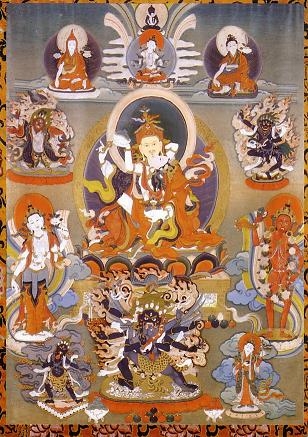Three Roots: Difference between revisions
Jump to navigation
Jump to search
mNo edit summary |
mNo edit summary |
||
| (11 intermediate revisions by 4 users not shown) | |||
| Line 1: | Line 1: | ||
'''Three Roots''' (Tib. ''tsawa sum''; ''rtsa ba gsum'') | [[Image:RigdzinDupaSm.JPG|frame|A [[thangka]] showing the deities of [[Longchen Nyingtik]], including the lama [[Rigdzin Düpa]], the yidam [[Palchen Düpa]], the khandro [[Yumka Dechen Gyalmo]], along with [[Dukngal Rangdrol]], [[Takhyung Barwa]], [[Senge Dongma]] and the protective deities.]]The '''Three Roots''' (Tib. ཙ་བ་གསུམ་, ''tsawa sum''; [[Wyl.]] ''rtsa ba gsum'') are: | ||
* | *[[lama]], | ||
* | *[[yidam]] and | ||
* | *[[khandro]]. | ||
''[[A Torch for the Path to Omniscience]]'' | "[They are] the inner [[refuge]] of the [[secret mantra|Secret Mantrayana]]. They are like the root or the basis for all the positive accumulations until you attain [[enlightenment]]."<ref>[[Chökyi Drakpa]], ''[[A Torch for the Path to Omniscience]]''</ref> | ||
According to the [[Vajrayana]], | |||
*the lama is seen as the [[Buddha]], | |||
*the yidam as the [[Dharma]], and | |||
*the khandro as the [[Sangha]]. | |||
As it says in the [[Longchen Nyingtik Ngöndro]] Refuge: | |||
:"Buddha, Dharma and Sangha are in reality lama, yidam and khandro."<ref>For further explanations on how the Three Roots are in reality the Three Jewels, see [[Yukhok Chatralwa Chöying Rangdrol]], {{LH|topics/ngöndro/yukhok-chatralwa/taking-refuge|''Taking Refuge''}} in his ''[[Ngöndro Compendium]]'', and [[Khenpo Ngawang Palzang]], ''A Guide to the Words of My Perfect Teacher'' (Boston: Shambhala, 2004), pages 122-123. </ref> | |||
==Three Roots Practices== | |||
In the [[Nyingma]] tradition, once we have accomplished the [[ngöndro]], we continue on the path with the [[sadhana]]s of the ‘Three Roots’, which are: | |||
*the practice of the lama, which is the root of all '''[[blessings]]''', | |||
*the practice of the yidam, which is the root of '''attainment''', or '''[[siddhi|accomplishment]]''', | |||
*the practice of the dakini (Tib. ''khandro''), which is the root of '''inspiration''' or '''activity'''. | |||
: | For [[About Rigpa|Rigpa]] students, the focus for the Three Roots practice is: | ||
*the lama practice of [[Rigdzin Düpa]]; | |||
*the yidam practice of [[Yang Nying Pudri]]; and | |||
*the dakini practice of [[Yumka Dechen Gyalmo]]. | |||
Whilst Rigdzin Düpa and Yumka Dechen Gyalmo are from the [[Longchen Nyingtik]] tradition, Yang Nying Pudri is a [[terma]] revealed by [[Tertön Sogyal]] (1856-1927), the predecessor of [[Sogyal Rinpoche]]. | |||
==Notes== | |||
<small><references/></small> | |||
[[Category:Key Terms]] | [[Category:Key Terms]] | ||
[[Category:Prayers and Practices]] | |||
[[Category:Vajrayana]] | |||
[[Category:Enumerations]] | [[Category:Enumerations]] | ||
[[Category: | [[Category:03-Three]] | ||
Latest revision as of 23:52, 30 June 2017

The Three Roots (Tib. ཙ་བ་གསུམ་, tsawa sum; Wyl. rtsa ba gsum) are:
"[They are] the inner refuge of the Secret Mantrayana. They are like the root or the basis for all the positive accumulations until you attain enlightenment."[1]
According to the Vajrayana,
As it says in the Longchen Nyingtik Ngöndro Refuge:
- "Buddha, Dharma and Sangha are in reality lama, yidam and khandro."[2]
Three Roots Practices
In the Nyingma tradition, once we have accomplished the ngöndro, we continue on the path with the sadhanas of the ‘Three Roots’, which are:
- the practice of the lama, which is the root of all blessings,
- the practice of the yidam, which is the root of attainment, or accomplishment,
- the practice of the dakini (Tib. khandro), which is the root of inspiration or activity.
For Rigpa students, the focus for the Three Roots practice is:
- the lama practice of Rigdzin Düpa;
- the yidam practice of Yang Nying Pudri; and
- the dakini practice of Yumka Dechen Gyalmo.
Whilst Rigdzin Düpa and Yumka Dechen Gyalmo are from the Longchen Nyingtik tradition, Yang Nying Pudri is a terma revealed by Tertön Sogyal (1856-1927), the predecessor of Sogyal Rinpoche.
Notes
- ↑ Chökyi Drakpa, A Torch for the Path to Omniscience
- ↑ For further explanations on how the Three Roots are in reality the Three Jewels, see Yukhok Chatralwa Chöying Rangdrol,
 Taking Refuge in his Ngöndro Compendium, and Khenpo Ngawang Palzang, A Guide to the Words of My Perfect Teacher (Boston: Shambhala, 2004), pages 122-123.
Taking Refuge in his Ngöndro Compendium, and Khenpo Ngawang Palzang, A Guide to the Words of My Perfect Teacher (Boston: Shambhala, 2004), pages 122-123.